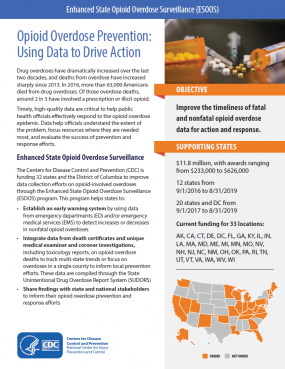Enhanced State Opioid Overdose Surveillance
Archived Content: This Page Is No Longer Being Updated
This page is archived for historical purposes and is no longer being maintained or updated.
Please see Overdose Data to Action (OD2A) for the most recent information on CDC-funded programs.
 [PDF - 790 KB]
[PDF - 790 KB]ESOOS Factsheet
Funding for Enhanced State Opioid Overdose Surveillance (ESOOS) will provide more timely and comprehensive data on fatal and nonfatal opioid overdoses and risk factors associated with fatal overdoses.
- September 2016: Approximately $4.3 million was awarded to 12 states to better track opioid-involved overdoses.
- September 2017: Approximately $7.5 million was awarded to 20 new states and Washington, D.C.
Through a competitive application process, CDC ESOOS $12.8 million in program funds have been awarded to: Alaska, California, Connecticut, Delaware, Florida, Georgia, Illinois, Indiana, Kentucky, Louisiana, Maine, Maryland, Massachusetts, Michigan, Minnesota, Missouri, Nevada, New Hampshire, New Jersey, New Mexico, North Carolina, Ohio, Oklahoma, Pennsylvania, Rhode Island, Tennessee, Utah, Vermont, Virginia, Washington, Washington D.C., West Virginia, and Wisconsin.
States will use the funding to:
- Increase the timeliness of reporting nonfatal opioid overdoses through syndromic surveillance (emergency department and emergency medical services data)
- Increase the timeliness and comprehensiveness of reporting fatal opioid overdoes through the State Unintentional Drug Overdose Reporting System (SUDORS), which captures detailed information on toxicology, death scene investigations, route of administration, and other risk factors that may be associated with a fatal overdose associated risk factors; and
- Disseminate surveillance findings to key stakeholders in order to inform prevention and response efforts for opioid-involved overdoses
As of September 2017, approximately $4.7 million was awarded for a program expansion. All awarded states and Washington D.C. will use the funding to:
- Directly support medical examiners and coroners, including for comprehensive toxicology testing (at least 60% of funds)
- Enhance their surveillance activities, including linking data sources, improving timeliness of nonfatal and fatal overdose data, and CDC-approved innovative projects
Funding for enhanced and timely surveillance is one of CDC’s key investments to inform opioid overdose prevention efforts. These new investments are made possible with the increased funds that Congress appropriated to CDC in fiscal year 2016 and 2017, which support the agency’s overarching Overdose Prevention in States (OPIS) effort. As the opioid overdose epidemic evolves, CDC will continue to provide scientific expertise, enhance surveillance activities, and tailor resources to address states’ growing and changing needs.

